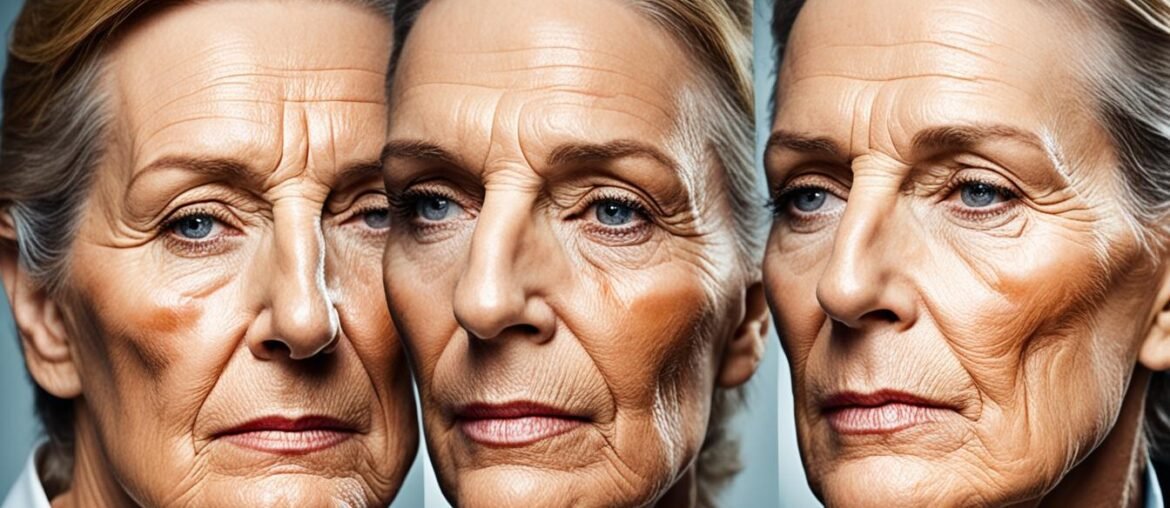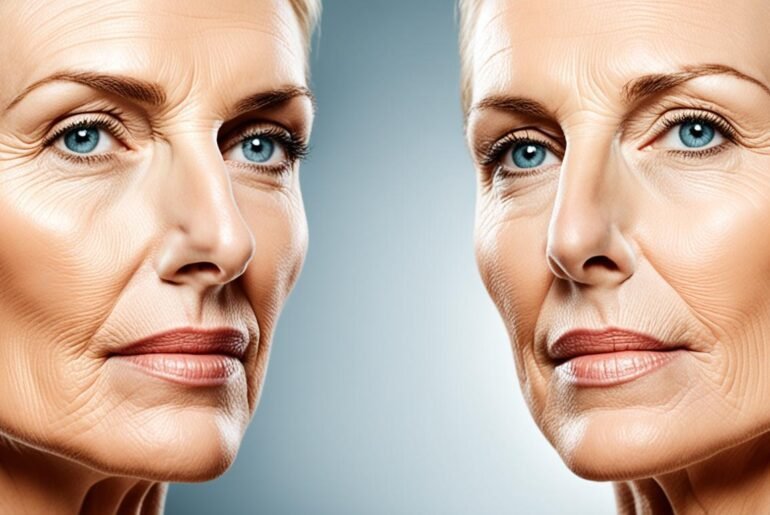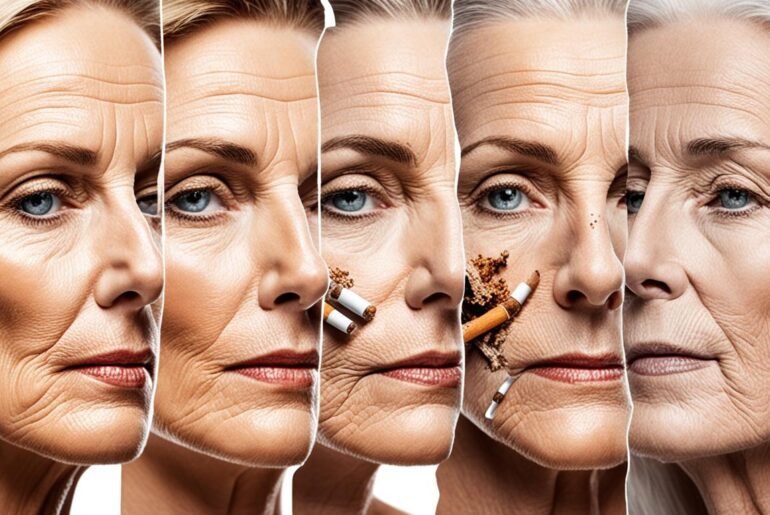Did you know that smoking not only harms your lungs but also wreaks havoc on your skin? In fact, the effects of smoking on skin wrinkles are staggering. Research shows that smoking is responsible for causing premature skin aging, leading to the development of wrinkles at an early age.
When you smoke, the toxins from tobacco smoke damage the collagen and elastin fibers in your skin. Collagen is responsible for maintaining the skin’s structure and firmness, while elastin allows the skin to stretch and bounce back. Smoking impairs collagen production, increases the breakdown of matrix proteins, and contributes to the abnormal production of elastosis material. This destructive process accelerates skin aging and ultimately leads to the formation of wrinkles.
But the damage doesn’t stop there. Smoking also reduces blood flow to the skin cells, depriving them of vital nutrients and oxygen. This reduction in blood flow disrupts the skin’s natural healing process and impairs its ability to retain moisture, resulting in dry, dull, and wrinkled skin.
So, if you’re a smoker concerned about the health and appearance of your skin, it’s essential to understand the detrimental effects smoking can have. In this article, we’ll delve deeper into how smoking contributes to premature skin aging, the mechanisms behind smoking-related wrinkles, and the potential for skin rejuvenation after quitting smoking. Discover the impact of tobacco on your skin health and gain valuable insights on how to reverse smoking-related skin damage.
Key Takeaways:
- Smoking is associated with premature skin aging and the development of wrinkles at an early age.
- Smoking impairs collagen production, increases elastin breakdown, and reduces skin moisture, leading to sagging and the formation of wrinkles.
- Quitting smoking can stop or even reverse some of the skin damage caused by smoking, improving collagen production and reducing the visibility of wrinkles.
- Adopting a comprehensive skincare routine, maintaining a balanced diet, exercising regularly, and using sunscreen can help reverse smoking-related skin damage.
- In-office treatments such as microneedling and laser resurfacing can promote skin rejuvenation and improve texture for smokers.
How Smoking Contributes to Premature Skin Aging
Smoking is not only harmful to your overall health but also has significant negative effects on your skin. The toxins in tobacco smoke can have detrimental effects on various aspects of skin health, ultimately leading to premature aging. Let’s explore how smoking contributes to premature skin aging and the specific mechanisms behind it.
Collagen Breakdown
Collagen is a protein that provides structure and elasticity to the skin. Unfortunately, smoking contributes to the breakdown of collagen, leading to sagging, wrinkles, and a loss of firmness. The toxins in tobacco decrease collagen production and accelerate its degradation, making the skin more susceptible to the signs of aging.
Elastin Reduction
Elastin is another protein responsible for maintaining skin elasticity and resiliency. Smoking reduces elastin production and promotes its breakdown, compromising the skin’s ability to bounce back from repetitive movements. This reduction in elastin contributes to the formation of fine lines, wrinkles, and overall skin laxity.
Decreased Blood Flow to Skin Cells
Smoking constricts blood vessels, resulting in decreased blood flow to the skin cells. This impaired circulation deprives the skin of essential nutrients and oxygen, further accelerating the aging process. Reduced blood flow also diminishes the skin’s ability to heal, leading to a prolonged recovery time for skin damage.
Decreased Moisture in the Dermis
The harmful chemicals in tobacco smoke disrupt the skin’s natural moisture balance, resulting in decreased hydration levels within the dermis. This loss of moisture leads to dryness, roughness, and an increased susceptibility to external environmental factors. Additionally, dry skin tends to show signs of aging more prominently, making wrinkles and fine lines appear more pronounced.
In summary, smoking significantly contributes to premature skin aging by breaking down collagen, reducing elastin levels, decreasing blood flow to the skin cells, and depleting the skin’s moisture content. The combined effects of these factors result in the development of premature wrinkles, sagging skin, and an overall aged appearance.
Mechanisms of Smoking-Related Wrinkles
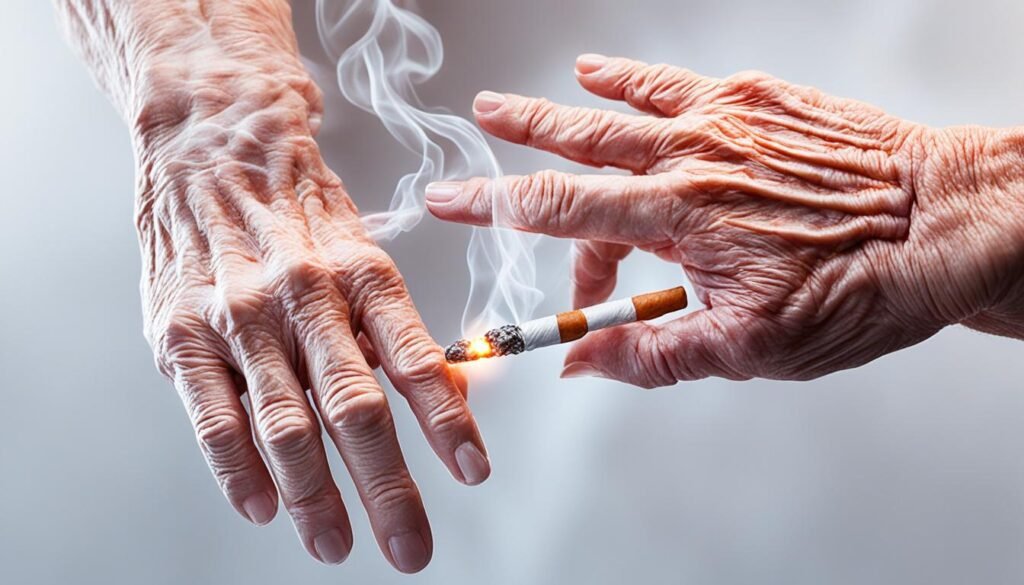
Smoking tobacco has a profound impact on the skin, leading to the development of premature wrinkles. The mechanisms through which smoking influences wrinkle formation are multifaceted and encompass collagen degradation, reduced skin moisture, and early-age wrinkle development.
Collagen, a vital component of the skin’s structure, is negatively affected by smoking. The toxins present in tobacco smoke impair collagen production and accelerate its breakdown. As a result, the skin loses its elasticity and firmness, leading to the appearance of wrinkles and sagging.
Smoking also disrupts the skin’s moisture balance, contributing to the prominence of wrinkles. The harmful substances in cigarettes reduce skin moisture levels, leaving the skin dry and prone to the development of fine lines and deep wrinkles.
Furthermore, smoking causes wrinkles to manifest at an earlier age compared to natural aging. The harmful chemicals in tobacco smoke expedite the aging process, resulting in the premature development of wrinkles. Smokers often exhibit more pronounced signs of skin aging, such as deep wrinkles and skin laxity, at a younger age than non-smokers.
Understanding the mechanisms behind smoking-related wrinkles underscores the importance of maintaining healthy skin and avoiding smoking. By quitting smoking and adopting proper skincare habits, individuals can mitigate the effects of smoking on the aging process and promote healthier, youthful-looking skin.
Can Quitting Smoking Reverse Skin Wrinkles?
Quitting smoking can have a positive impact on the development of skin wrinkles. Studies show that the cessation of smoking can stop or even reverse some of the skin damage caused by tobacco. Former smokers have demonstrated improved collagen production, which plays a crucial role in maintaining skin elasticity. Additionally, quitting smoking has been linked to a reduction in the development of age spots and hyperpigmentation, contributing to a more youthful complexion.
While complete reversal of smoking-related wrinkles may not be guaranteed, quitting smoking can help increase collagen production and make wrinkles less visible. The body’s ability to heal and restore itself improves when tobacco use is eliminated. By quitting smoking, individuals provide their skin with a chance to rejuvenate and repair the damage caused by years of smoking.
It is important to note that the impact of quitting smoking on skin wrinkles may vary from person to person. Factors such as the duration and intensity of smoking, as well as an individual’s overall skin health, can influence the extent of wrinkle improvement. However, quitting smoking is undoubtedly a critical step toward healthier skin and overall well-being.
Tips for Reversing Smoking-Related Skin Damage
Aside from quitting smoking, there are several important steps you can take to reverse the skin damage caused by smoking. By following these tips, you can improve your skin’s health and restore its natural radiance.
1. Maintain a Balanced Diet:
Eating a diet rich in vitamins and minerals is essential for skin health. Include plenty of fruits, vegetables, whole grains, and lean proteins in your meals. These nutrient-dense foods provide antioxidants that help combat the harmful effects of smoking on your skin.
2. Exercise Regularly:
Engaging in regular physical activity promotes blood circulation, which is crucial for delivering oxygen and essential nutrients to your skin cells. Exercise also stimulates the production of antioxidants, which can help repair and rejuvenate your skin.
3. Get Adequate Sleep:
Sleep plays a vital role in skin repair and collagen production. Aim for 7-9 hours of quality sleep each night to allow your skin to heal and regenerate. This will help reduce the appearance of wrinkles and promote a more youthful complexion.
4. Use Sunscreen Daily:
Protecting your skin from further damage is crucial. Apply a broad-spectrum sunscreen with an SPF of 30 or higher every day, even during cloudy or winter days. This will shield your skin from harmful UV rays that can exacerbate smoking-related skin damage.
5. Establish a Skincare Routine:
Adopting a consistent skincare routine is essential for reversing smoking-related skin damage. Cleanse your face twice daily to remove dirt and impurities. Follow up with a moisturizer to hydrate your skin and restore its natural moisture barrier. Gentle exfoliation can help remove dead skin cells and improve skin texture. Consider incorporating serums enriched with antioxidants to further nourish and revitalize your skin.
By implementing these tips into your daily routine, you can effectively combat smoking-related skin damage and restore your skin’s health and vitality.
In-Office Treatments for Smoker’s Skin
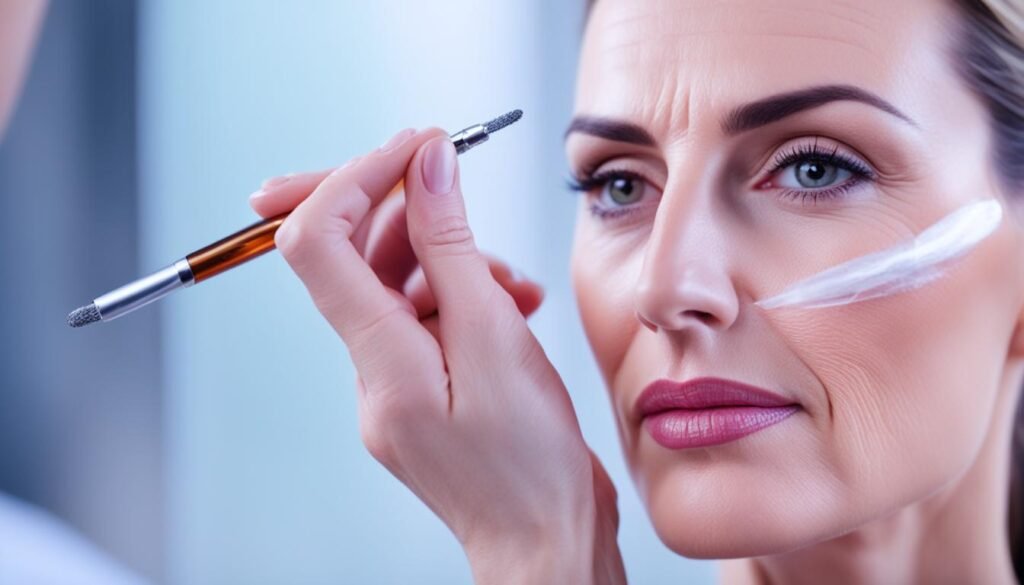
If you’re looking to improve the appearance of your skin and reduce the signs of aging caused by smoking, there are several effective in-office treatments available. These procedures target specific skin concerns such as texture improvement and wrinkles, helping you achieve a healthier and more youthful complexion.
Microneedling for Skin Texture Improvement
Microneedling is a popular in-office treatment that uses a device with fine needles to create tiny punctures in the skin. This process stimulates collagen production and enhances skin texture. By promoting natural collagen formation, microneedling can help reduce the appearance of wrinkles and fine lines caused by smoking.
“Microneedling is a minimally invasive procedure that encourages the rejuvenation of your skin. It can improve skin texture and firmness, making it an effective treatment for smoker’s skin.” – Dr. Elizabeth Thompson, Dermatologist
Laser Resurfacing for Wrinkle Reduction
Laser resurfacing is another in-office treatment that can effectively reduce wrinkles caused by smoking. It uses focused laser beams to remove damaged skin cells and stimulate collagen production. Laser resurfacing can help improve skin tone and texture, diminishing the appearance of wrinkles and fine lines.
“Laser resurfacing is a highly precise treatment that can target specific areas of concern. By promoting collagen production, it can effectively reduce wrinkles caused by smoking.” – Dr. Michael Reynolds, Cosmetic Surgeon
Both microneedling and laser resurfacing are safe and effective procedures that can be tailored to your specific skin needs. Your dermatologist or cosmetic surgeon will evaluate your skin condition and recommend the most suitable treatment for you.
Image:
Resources for Quitting Smoking
Quitting smoking can be a challenging journey, but you don’t have to do it alone. There are various resources available to provide support and guidance, increasing your chances of success. Here are some valuable resources for quitting smoking:
Nicotine Replacement Therapy
Nicotine replacement therapy (NRT) involves using products that deliver nicotine to the body without the harmful chemicals found in cigarettes. NRT can help reduce cravings and withdrawal symptoms, making it easier to quit smoking. Common NRT products include nicotine patches, gum, lozenges, inhalers, and nasal sprays. Consult with a healthcare professional to determine the most suitable NRT option for you.
Support Groups
Joining a support group can provide a safe and understanding environment where you can connect with others who are also on the journey to quit smoking. Sharing experiences, receiving encouragement, and learning coping strategies from others who have gone through or are going through similar challenges can be immensely helpful. Look for local support groups in your area or consider online support groups if that is more accessible for you.
Quitline Services
Quitline services offer free and confidential telephone counseling for individuals who want to quit smoking. Trained counselors can provide personalized advice, tips, and support to help you develop a quit plan, deal with cravings, and stay motivated. Quitline services often have extended hours and can connect you with additional resources and programs specific to your region.
Mobile Apps for Quitting Smoking
Take advantage of technology by using mobile apps designed to assist you in quitting smoking. These apps can track your progress, provide motivation, offer smoking cessation techniques, provide health benefits information, and even connect you with a community of supportive individuals. Some popular quitting smoking apps include Smoke Free, QuitNow!, and My QuitBuddy. Explore different apps to find the one that aligns with your needs and preferences.
Remember, quitting smoking is a personal journey, and it’s important to find the resources that resonate with you and your unique circumstances. Whether you choose to combine multiple strategies or focus on one approach, the most important thing is to stay committed and seek support whenever you need it. You can do it!
The Effects of Smoking on Skin Health and Appearance

Smoking not only impacts the development of wrinkles and skin aging but also has significant effects on overall skin health and appearance. Several key factors contribute to these negative effects.
Reduced Collagen and Elastin Levels
Collagen and elastin are crucial proteins that maintain the structure, firmness, and elasticity of the skin. However, smoking disrupts the production of these proteins, leading to reduced collagen and elastin levels. As a result, the skin becomes prone to sagging, and the loss of firmness becomes noticeable, contributing to premature aging and an aged appearance.
Skin Discoloration
Smoking can also cause skin discoloration, particularly in areas exposed to continued cigarette smoke. The toxins in tobacco can trigger the production of excess melanin, resulting in uneven skin tone, dark patches, and an overall dull complexion. This discoloration can have a significant impact on the skin’s appearance, making it look lackluster and aged.
Thinning of the Skin
Another detrimental effect of smoking is the thinning of the skin. Smoking leads to a decrease in blood flow to the skin, which affects the delivery of oxygen and nutrients, crucial for maintaining the skin’s thickness. As a result, the skin becomes thinner, more fragile, and susceptible to damage. Thinning of the skin can also contribute to a more aged appearance, including the development of fine lines and wrinkles.
The image above visually represents the effects of smoking on skin health, highlighting the reduced collagen and elastin levels, skin discoloration, and thinning of the skin caused by smoking.
The Relationship Between Smoking and Skin Cancer
Smoking has been linked to an increased risk of various types of skin cancer, including basal cell carcinoma, squamous cell carcinoma, and melanoma. Studies suggest that there is a relationship between smoking-related cancers and the development of skin cancer.
Conclusion
In conclusion, smoking plays a significant role in causing premature skin wrinkles and accelerating the aging process of the skin. The harmful toxins in tobacco smoke impair collagen production, leading to a loss of skin elasticity and firmness.
Furthermore, smoking increases the breakdown of elastin, which is responsible for maintaining the skin’s structure and flexibility. This degradation contributes to sagging skin and the development of wrinkles at an early age.
Additionally, smoking reduces skin moisture and blood flow to the skin cells, further exacerbating the negative effects on skin health. However, it is not all doom and gloom, as quitting smoking can help reverse some of the damage caused by smoking.
By quitting smoking and adopting a comprehensive skin care routine, including a balanced diet, regular exercise, proper moisturization, and the use of sunscreen, individuals can improve their overall skin health and reduce the visibility of wrinkles caused by smoking. Taking these steps is crucial for anyone looking to regain a youthful and vibrant complexion.
FAQ
What is the role of smoking in premature skin wrinkles?
Smoking is responsible for premature skin aging and wrinkles. It impairs collagen production, increases the breakdown of elastin, reduces skin moisture, and decreases blood flow to the skin cells.
How does smoking contribute to premature skin aging?
Smoking contributes to premature skin aging by breaking down collagen and elastin fibers, leading to sagging, wrinkling, and loss of firmness. It also reduces skin moisture, making wrinkles more prominent.
Smoking-related wrinkles occur due to collagen degradation, reduced skin moisture, and the development of wrinkles at an earlier age compared to natural aging.
Can quitting smoking reverse skin wrinkles?
Quitting smoking can stop or even reverse some of the skin damage caused by smoking. Former smokers have shown improved collagen production and reduced development of age spots and hyperpigmentation after quitting smoking.
Yes, apart from quitting smoking, tips for reversing smoking-related skin damage include maintaining a balanced diet, regular exercise, adequate sleep, using sunscreen, and following a good skincare routine.
What are the in-office treatments for smoker’s skin?
In-office treatments such as microneedling and laser resurfacing can help improve skin texture and reduce the appearance of wrinkles caused by smoking. These procedures stimulate collagen production and promote skin rejuvenation.
What resources are available for quitting smoking?
Resources for quitting smoking include nicotine replacement therapy, support groups, quitline services, and mobile apps designed to help individuals reduce cravings and provide guidance during the quitting process.
How does smoking affect skin health and appearance?
Smoking reduces collagen and elastin, leading to sagging and loss of firmness. It can also cause skin discoloration and thinning, impacting overall skin health and appearance.
Is there a relationship between smoking and skin cancer?
Yes, smoking has been linked to an increased risk of various types of skin cancer, including basal cell carcinoma, squamous cell carcinoma, and melanoma.
What is the conclusion regarding smoking’s role in premature skin wrinkles?
Smoking accelerates skin aging and contributes to the development of premature wrinkles. However, quitting smoking and adopting a comprehensive skincare routine can help reverse some of the damage caused by smoking and improve overall skin health.

